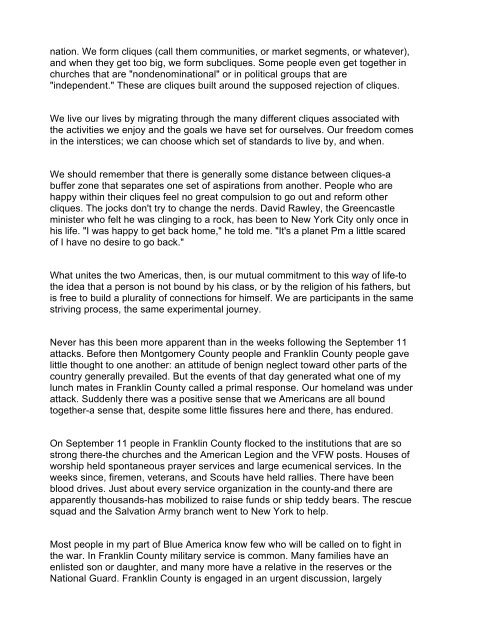One Nation, Slightly Divisible by David Brooks - Saddleback College
One Nation, Slightly Divisible by David Brooks - Saddleback College
One Nation, Slightly Divisible by David Brooks - Saddleback College
Create successful ePaper yourself
Turn your PDF publications into a flip-book with our unique Google optimized e-Paper software.
nation. We form cliques (call them communities, or market segments, or whatever),<br />
and when they get too big, we form subcliques. Some people even get together in<br />
churches that are "nondenominational" or in political groups that are<br />
"independent." These are cliques built around the supposed rejection of cliques.<br />
We live our lives <strong>by</strong> migrating through the many different cliques associated with<br />
the activities we enjoy and the goals we have set for ourselves. Our freedom comes<br />
in the interstices; we can choose which set of standards to live <strong>by</strong>, and when.<br />
We should remember that there is generally some distance between cliques-a<br />
buffer zone that separates one set of aspirations from another. People who are<br />
happy within their cliques feel no great compulsion to go out and reform other<br />
cliques. The jocks don't try to change the nerds. <strong>David</strong> Rawley, the Greencastle<br />
minister who felt he was clinging to a rock, has been to New York City only once in<br />
his life. "I was happy to get back home," he told me. "It's a planet Pm a little scared<br />
of I have no desire to go back."<br />
What unites the two Americas, then, is our mutual commitment to this way of life-to<br />
the idea that a person is not bound <strong>by</strong> his class, or <strong>by</strong> the religion of his fathers, but<br />
is free to build a plurality of connections for himself. We are participants in the same<br />
striving process, the same experimental journey.<br />
Never has this been more apparent than in the weeks following the September 11<br />
attacks. Before then Montgomery County people and Franklin County people gave<br />
little thought to one another: an attitude of benign neglect toward other parts of the<br />
country generally prevailed. But the events of that day generated what one of my<br />
lunch mates in Franklin County called a primal response. Our homeland was under<br />
attack. Suddenly there was a positive sense that we Americans are all bound<br />
together-a sense that, despite some little fissures here and there, has endured.<br />
On September 11 people in Franklin County flocked to the institutions that are so<br />
strong there-the churches and the American Legion and the VFW posts. Houses of<br />
worship held spontaneous prayer services and large ecumenical services. In the<br />
weeks since, firemen, veterans, and Scouts have held rallies. There have been<br />
blood drives. Just about every service organization in the county-and there are<br />
apparently thousands-has mobilized to raise funds or ship teddy bears. The rescue<br />
squad and the Salvation Army branch went to New York to help.<br />
Most people in my part of Blue America know few who will be called on to fight in<br />
the war. In Franklin County military service is common. Many families have an<br />
enlisted son or daughter, and many more have a relative in the reserves or the<br />
<strong>Nation</strong>al Guard. Franklin County is engaged in an urgent discussion, largely

















